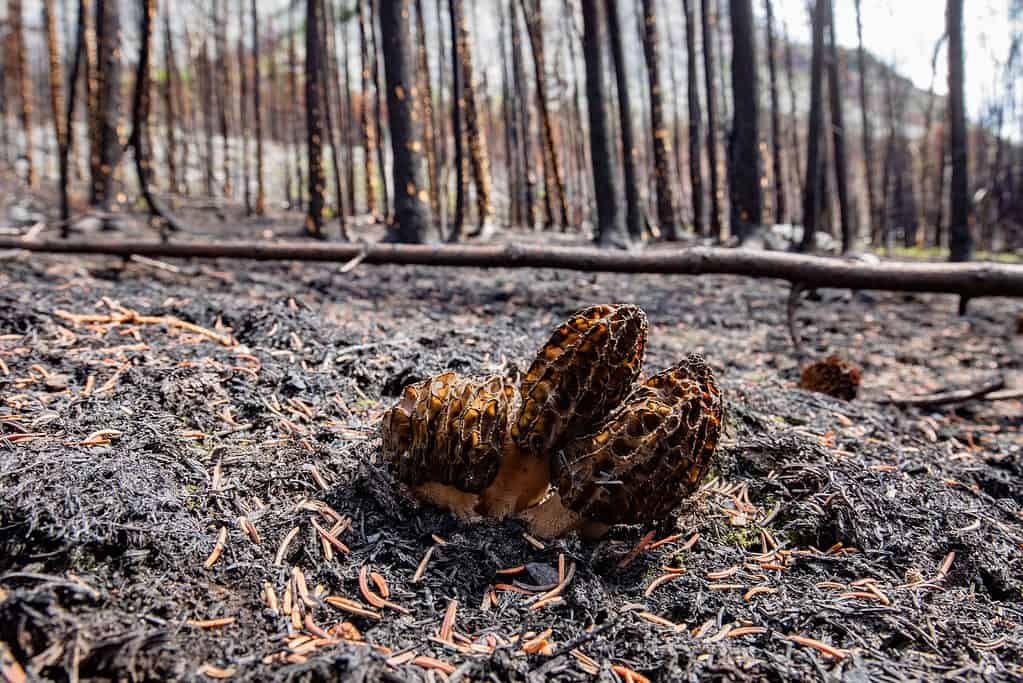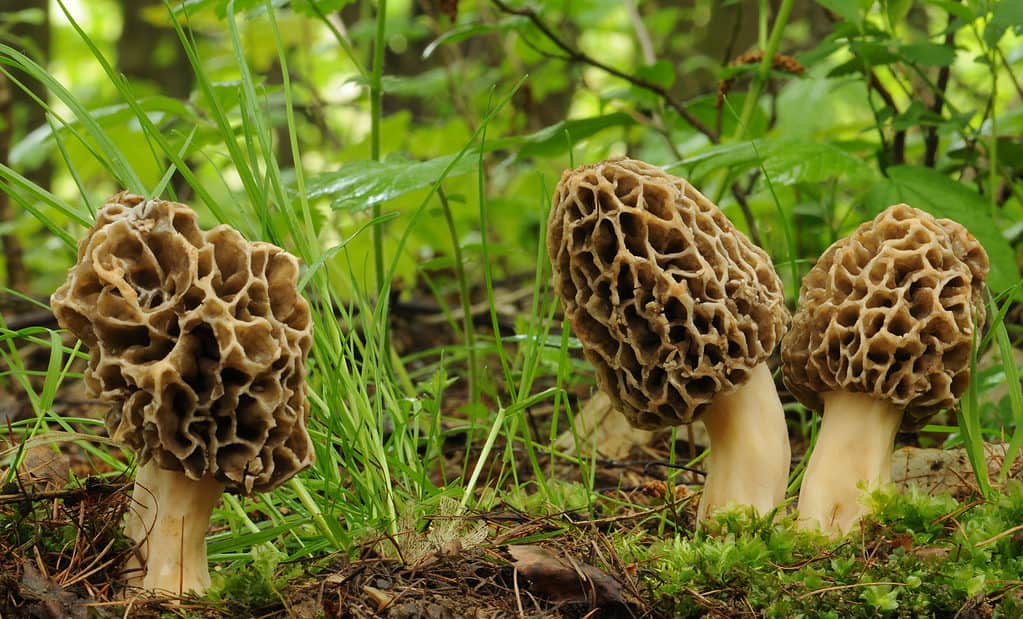If you enjoy foraging mushrooms, you’re likely familiar with the sought-after, choice edible, morel. Each spring, foragers head out across North America in droves to search for these delicious mushrooms. If you’d like to hunt for these tasty fungi, you’ll need to know where and how they grow.
In this guide, we’ll cover the fungal classification of these mushrooms, where they grow, their ecological roles, and the various types of trees that morels grow around.
What Are Morel Mushrooms?
True morels belong to the Morchella genus in the Morchellaceae family of the Pezizales order and the Ascomycota phylum. Ascomycota fungi are also called sac fungi in reference to their internal sac-like structures, called asci, that produce their sexually-produced spores called ascospores. In North America, genetic analysis divides the 20 confirmed morel species into three evolutionary clades: elata, esculenta, and rufobrunnea.
Characteristics
We typically characterize true morels by morphological features like having a hollow interior from the tip of the cap to the bottom of the stem, and a spongy, honeycomb-like pitted cap. The caps are often oblong to conical in shape. The majority of true morels caps are also fully attached to the stem (aka the stipe), meaning the bottom of the caps do not freely overhang the stipe. However, an exception is the half-free morels, which feature a cap bottom that is partially attached to the stipe.

Characteristics of true morels include a hollow interior and a spongy, honeycomb-like pitted cap.
©iStock.com/Helin Loik-Tomson
Native Distribution and Ecology
Morels occur natively across forested and tree-less, temperate regions of the Northern Hemisphere, from North and Central America to Europe and Asia. Their fruiting season generally ranges from late March through June.
The ecological roles of morels are a bit complex, as we can’t neatly divide them into either saprobic or mycorrhizal. Saprobic fungi derive their nutrients from breaking down decomposing organic matter. Mycorrhizal fungi obtain their nutrients from a complex, mutually beneficial relationship with host plants. In this beneficial relationship, the mycelium of morels brings essential nutrients to the roots of their host trees, in exchange for sugars from the trees.
Currently, research demonstrates that morels can exhibit both saprobic and possibly mycorrhizal behaviors during their complex life cycles. What species of trees they develop partnerships with depends on the species of morel. Additionally, some species of morel appear to exhibit more saprobic behavior throughout their life cycle. For example, Morchella rufobrunnea and Morchella importuna tend to be primarily saprobic.
Elata and Esculenta Clade Morels and Their Tree Hosts
If you’ve noticed morels appearing every spring near the same species of trees, the mycelium have likely formed some kind of relationship with those trees. Since the one North American species in the rufobrunnea clade appears to be primarily saprobic (Morchella rufobrunnea), we’ll focus on the tree partnerships of morels in the elata and esculenta clades.
Trees that Morels Grow Around: Black, Burn-site, and Half-Free Morels of the Elata Clade
The elata clade currently contains 14 species in North America and represents the black, half-free, and burn-site morels.
One of the most widespread eastern North American black morels, Morchella angusticeps, appears to have a relationship with hardwood trees. Specifically, foragers often find this species growing near white and green ash, tulip, cherry, and aspen trees.
Morchella punctipes and Morchella populiphila are the half-free morel species in North America. These two species may be both saprobic and form relationships with trees at various points in their life cycles. Forages often find them growing in association with hardwood trees such as black cherry, tulip poplar, elm, and white and green ash.
Finally, some species of morels, commonly known as burn or burn-site morels of the elata clade, may only appear, typically in large flushes, after a forest fire. Mycologists currently suspect that burn morels, such as Morchella septimelata, are both saprobic and form associations with trees at different stages of their life cycle. Mostly, burn morels appear in conifer forests West of the Rockies after a fire. Foragers and commercial harvesters can often find them in quite large flushes after a forest fire near conifers such as spruce, fir, and pine trees.

Burn-site morels grow in forest areas that have recently burned.
©Pi-Lens/Shutterstock.com
Trees that Morels Grow Around: Yellow Morels of the Esculenta Clade
Mycologists currently recognize five North American species of morels in the esculenta clade (commonly referred to as yellow morels). Morchella americana is by far the most well-known and is distributed across North America. Other species, such as Morchella prava, are less commonly known and only occur in the northern portion of North America. You can usually find these morels growing under many hardwood species. Examples of such are white and green ash, American elm, tulip poplar, cottonwood, pear, and apple trees. Some people even claim to find them around Sycamore trees. Morchella americana is particularly prolific across North America, likely in part because it may have an especially high number of possibly mycorrhizal tree hosts.

There are currently five species of North American morels in the
esculentaclade.
©Tomasz Czadowski/Shutterstock.com
Summary Of The Types of Trees That Morel Mushrooms Grow Around
| Number | Mushroom Type | Tree Type |
|---|---|---|
| Elata Clade | ||
| 1 | North American Black Morels (Morchella angusticeps) | White and green ash, tulip, cherry, and aspen trees |
| 2 | Half-free Morels (Morchella punctipes) and (Morchella populiphila) | Black cherry, tulip poplar, elm, and white and green ash |
| 3 | Burn-site Morels (Morchella septimelata) | Spruce, fir, and pine trees |
| Esculenta Clade | ||
| 4 | Yellow Morels (Morchella Americana) | White and green ash, American elm, tulip poplar, cottonwood, pear, apple trees and possibly sycamore |
| 5 | Yellow Morels (Morchella prava) | White and green ash, American elm, tulip poplar, cottonwood, pear, apple trees and possibly sycamore |
The photo featured at the top of this post is © Mircea Costina/Shutterstock.com
The information presented on or through the Website is made available solely for general informational purposes. We do not warrant the accuracy, completeness, or usefulness of this information. Any reliance you place on such information is strictly at your own risk. We disclaim all liability and responsibility arising from any reliance placed on such materials by you or any other visitor to the Website, or by anyone who may be informed of any of its contents. None of the statements or claims on the Website should be taken as medical advice, health advice, or as confirmation that a plant, fungus, or other item is safe for consumption or will provide any health benefits. Anyone considering the health benefits of particular plant, fungus, or other item should first consult with a doctor or other medical professional. The statements made within this Website have not been evaluated by the Food and Drug Administration. These statements are not intended to diagnose, treat, cure or prevent any disease.
Thank you for reading! Have some feedback for us? Contact the AZ Animals editorial team.






